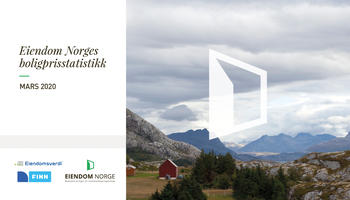
Strong rise in housing prices in January
House prices rose by 3.4 per cent in January 2024. Adjusted for seasonal variations, house prices rose by 0.7 per cent.
The average price for a home in Norway was NOK 4,527,937 at the end of January.
- House prices rose sharply by 3.4 per cent in January, which resulted in an increase of 0.7 per cent seasonally adjusted. The housing market is back, says managing director Henning Lauridsen of Eiendom Norge.
- The positive increase in January is sensational in light of the weak development in the Norwegian mainland economy and not least the surprising interest rate increase in December. Now many people have to revise their models, including us, as our forecast for January of 2.5% was flat, says Lauridsen.
- Most of the house price growth over the course of a year occurs in the first half of the year, and particularly in January with the so-called January effect. Given the positive development in January, it will be very exciting to follow the development going forward. A strong second-hand housing market will have a positive effect on the new housing market, where there has been a historically weak development since the summer of 2022, he says.
Good activity and the inventory is being reduced
In January, 6,757 homes were sold in Norway, which is 2.2 percent fewer than the corresponding month in 2023.
In January, 5,876 homes were put up for sale in Norway, which is 5.8 percent fewer than in the same month in 2023.
- Far more homes have been sold than are advertised and the inventory that built up over the autumn is now in the process of being reduced. The number of unsold homes on the market has fallen throughout the month, says Lauridsen.
It took an average of 67 days to sell a home in January, up from 62 days in December. Stavanger and surrounding area had the shortest sales time of 34 days. Tromsø had the longest sales time with 106 days.
Upswing in almost all areas
Porsgrunn/Skien had the strongest seasonally adjusted price development in January, where prices rose by 2.2 per cent.
Fredrikstad/Sarpsborg had the weakest seasonally adjusted price development, with a seasonally adjusted decrease of 0.7 per cent.
- With the exception of Fredrikstad/Sarpsborg and Kristiansand and surroundings, there was an increase in the seasonally adjusted prices in all areas. In some areas, the seasonally adjusted increase was very strong, says Lauridsen.
Norges Bank and housing investments
Throughout 2023, falling housing investment has dragged down the Norwegian economy, and at the moment there is a rare gap of almost 10 percentage points in Statistics Norway's and Norges Bank's forecasts for housing investment in 2024.
- Norges Bank has not taken into account what the sharp slowdown in new home sales will mean for the Norwegian economy and how this will affect housing investment going forward. Housing construction is a tanker that takes a long time to turn around, and many things can indicate that the models are not able to capture large market fluctuations, says Lauridsen.
- If Norges Bank is wrong about developments in housing investment, which we believe they are doing, it will have a major impact on interest rate setting going forward, he says.
- Given the mandate to also facilitate high and stable production and employment, this means that Norges Bank will have to adjust the interest rate path down in March and probably also lower the policy rate, concludes Lauridsen.
Further information:
When referencing Eiendom Norge's house price statistics, Eiendom Norge, FINN and Eiendomsverdi AS must be given as the source.
Note that some changes have been made to the statistics from January onwards and that the method has been improved.
Also note that the housing price statistics' history has been revised for the period 2010-2023.
Read more about it here.
Please note that for the January 2024 figures, parking spaces have been measured incorrectly for 159 out of 6,757 sold in connection with the transition to the new standard for measuring the area of homes. These are removed before the statistics are calculated.






